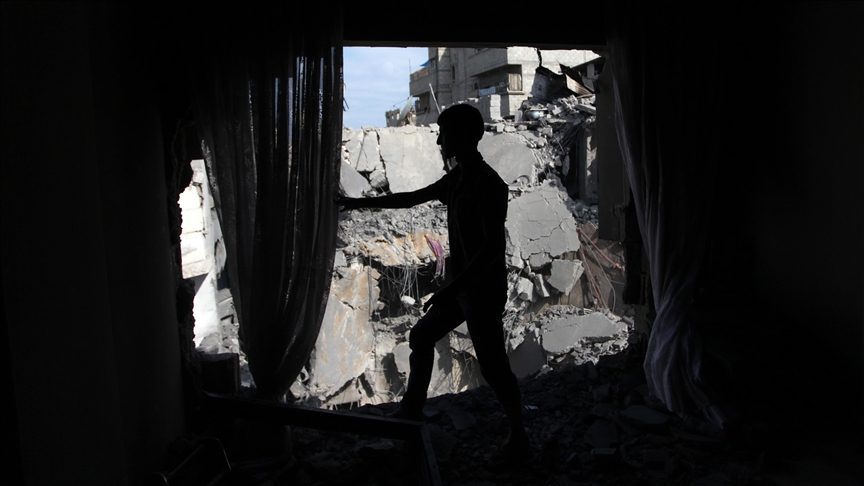FACTBOX – Genocide in numbers: Israel’s destruction of Gaza
Over 17,000 students, 10,000 women, 20,000 children, 540 aid workers, 254 journalists reported killed

Nearly 90% of Gaza’s population faces acute food insecurity
Israeli attacks damage 80 to 90% of structures, 62% of roads, most schools and hospitals, according to governmental, UN figures
ISTANBUL
After two years of almost nonstop bombardment, Israel’s genocidal war has left the Gaza Strip in ruins, with international organizations and local monitors documenting mass casualties, widespread destruction, famine and the collapse of basic infrastructure.
According to the Gaza Health Ministry, the Israeli army has killed at least 67,160 people and injured 169,679 others since October 2023.
With a current population of about 2.1 million, more than 10% of Gaza’s residents have been killed or wounded.
Gaza's government media office reported that the number of deaths and missing individuals has reached over 76,600.
Civilians have borne the brunt of the violence. The UN Human Rights Office reported that over six months, from November 2023 to April 2024, nearly 70% of verified victims were women and children.
Since the ceasefire broke down in March, the indiscriminate attacks appear to have intensified. Fifteen out of every 16 Palestinians killed by the army were civilians since then, said the independent global violence monitor Armed Conflict Location & Event Data (ACLED).
In June, the Israeli daily Haaretz cited a pre-print academic study suggesting that official fatality figures may be conservative. Based on direct attacks as well as indirect consequences of the war, the study estimated nearly 100,000 deaths in Gaza.
Famine claiming lives
With about 98% of Gaza’s cropland damaged or inaccessible and Israel blocking most food aid, access to food has been severely restricted.
In late August, the Integrated Food Security Phase Classification (IPC), a UN-backed monitoring system, officially declared a famine, reporting that more than half a million people were facing catastrophic conditions.
Famine is confirmed when three thresholds are crossed – extreme lack of food, high rates of acute malnutrition and evidence of starvation-related deaths.
The situation has steadily worsened, according to the IPC.
In the first year of the conflict, about 1.84 million people in Gaza faced high levels of acute food insecurity, classified as crisis level or worse. By mid-2025, that number had risen to nearly 1.94 million – around 90% of the population.
At least 460 people have died from starvation, including 154 children, according to Health Ministry figures released on Oct. 6.
Four people died of hunger in 2023 and 49 in 2024. The majority of deaths occurred in 2025, with more than 182 reported since the famine was officially declared.
Children of Gaza
Gaza has one of the youngest populations in the world, and children have been among the worst affected, both physically and mentally.
The Health Ministry said nearly 20,000 children have been killed and more than 42,000 injured, making up over 30% of the death toll.
In two years, an estimated 1,015 babies under one year old were directly killed, according to Gaza's government media office.
Children have also been particularly vulnerable to starvation. They accounted for about one-third of those who died of hunger.
Since late August, at least 39 children have died of starvation – almost one per day.
The Health Ministry said that 51,196 children under five are suffering from severe malnutrition.
UNICEF estimated that 26,000 Gaza children require medical treatment for acute malnutrition. If the situation continues, the agency said 43,400 children will be at severe risk of death from malnutrition by June 2026.
At the same time, more than 56,000 Palestinian children lost one or both parents in the Israeli onslaught as of August, according to UNICEF.
The agency also reported that 1 million children require mental health treatment and psychosocial support to cope with trauma and damage caused by the war.
Women of Gaza
More than 10,100 Palestinian women have been killed and nearly 23,000 injured, according to Health Ministry figures.
According to the World Health Organization (WHO), the war has taken a severe toll on pregnant and breastfeeding women, with more than 40% severely malnourished.
The Health Ministry reported in early September that 55,000 women are malnourished and 67% are suffering from anemia – the highest rate in years.
According to the UN, 23,000 pregnant women are going without care during delivery, and about 15 babies are being born each week with no medical assistance.
Lives lost on the path to food
Amid the severe food shortage, seeking aid at distribution sites backed by the US and Israel has become perilous.
These militarized supply sites began operating in late May after Israel cut off the entry of food and other goods into Gaza.
Some 2,610 people have been killed and 19,143 injured while trying to obtain food at these sites, according to the Gaza Health Ministry.
Some 108 Israeli attacks on food distribution points and centers were recorded, according to the government media office.
Earlier in September, the UN Office for the Coordination of Humanitarian Affairs (OCHA) reported 2,256 deaths at the sites, most resulting from live fire.
Humanitarian, health workers
The Israeli army has killed at least 540 aid workers and 1,722 health workers, according to OCHA.
The government media office reported that more than 1,800 humanitarian workers, including health personnel, have been killed. Over 780 police officers and personnel working in aid delivery were killed.
Victims include paramedics, doctors and other locally employed health staff, as well as members of international organizations such as the Red Crescent, Doctors Without Borders and World Central Kitchen.
Journalists' death toll
At least 254 journalists have been killed in Gaza, according to the Gaza government. The International Federation of Journalists (IFJ) has reported similar figures.
The first year of the war was the deadliest for media workers, with 175 killed.
At the same time, 50 journalists were detained and 120 media institutions were destroyed, according to the Palestinian Journalists Syndicate.
Athletes and artists
Even those whose jobs tend to be far from the frontlines have been killed in large numbers.
At least 894 athletes have been killed, according to government figures. The Palestinian Football Association reported 776 deaths.
Israeli strikes have also targeted 288 sports centers, causing partial or complete destruction.
At least 45 artists, writers and cultural activists were killed in the first six months of the war, according to the Palestinian Culture Ministry.
PEN International, a London-based writers’ union, confirmed that 41 Palestinian writers and poets died in the first year.
Collapse of Gaza’s healthcare system
The Israeli army carried out 778 attacks on health facilities, damaging 34 hospitals, 91 medical centers and 210 ambulances, according to the WHO.
As a result, more than half of Gaza’s 228 hospitals and primary health care centers went out of service, said OCHA.
Twenty-five of Gaza’s 38 hospitals stopped functioning, while the remaining 13 are partially operating under harsh conditions, the Health Ministry said.
According to the Gaza government, Israel’s targeting of health facilities deprived more than 2 million people of medical services, including 50,000 pregnant women and 12,000 cancer patients in the first year.
Health Ministry figures also showed that more than 400 dialysis patients – about 40% of all such cases in Gaza – died in the first 18 months of conflict.
The WHO has reported that 15,800 patients in critical condition require evacuation abroad. According to the Health Ministry, 5,580 children among 18,000 patients were denied medical evacuation.
Meanwhile, over 83% of people with disabilities in Gaza lack assistive devices such as wheelchairs and hearing aids, according to a UN report in August.
Collapse of education
Two years of attacks have also devastated Gaza’s schools and universities.
UN figures show that 17,237 students, 1,271 university students and 967 educational staff were killed.
According to Gaza’s Education Ministry, more than 25,700 students and 3,100 teachers were injured.
Sixty-three university buildings were also destroyed.
With most education disrupted, nearly 660,000 children remain out of school, according to the UN agency for Palestinian refugees, or UNRWA.
OCHA reported that 97% of school buildings were partially or completely damaged.
Religious structures
Religious sites have also been hit.
More than 835 mosques were completely destroyed, over 180 sustained partial damage, while three churches in Gaza have been targeted several times, the government media office said.
According to Gaza’s Endowments Ministry, at least 79% of mosques were destroyed and three churches damaged.
The Israeli army also killed 255 clerics and imams and detained 26, the ministry said.
More than half of Gaza’s 60 cemeteries have also been struck, with 14 completely destroyed and 18 partially damaged.
Destruction of infrastructure
The destruction of infrastructure has also been a trademark of the war.
Nearly 80% of all Gaza’s structures and 62% of the road network have been damaged or destroyed, OCHA reported.
The Gaza government said Israel dropped more than 200,000 tons of explosives, destroying nearly 90% of the enclave and causing losses exceeding $70 billion.
According to the UN Food and Agriculture Organization (FAO), 83% of agricultural wells and 71% of greenhouses were damaged as of April 2025.
Some 725 central water wells were destroyed, government data showed.
Water systems have also collapsed, with 96% of households facing water insecurity, the UN said in July.
Mass displacement campaigns
Almost all of Gaza’s population has been forced to move at some point, many multiple times.
More than 1.9 million people have been displaced, according to OCHA.
Over 80% once lived in areas subject to evacuation orders or heavy bombardment.
More than 90% of homes have been targeted, with 60,000 completely destroyed and 276,000 damaged.
Around 1.4 million people now require emergency shelter and household goods.
In September, Israel ordered residents of Gaza City to leave, displacing more than 200,000, the UN said, while Israeli authorities claimed over 550,000 had departed.
Gaza's government media office said on Sept. 20 that more than 900,000 people remain in Gaza City and northern areas despite evacuation orders and bombardment.
Seventeen displaced people, 14 of them children, froze to death in refugee camps, the office said.
Israel has designated just 12% of Gaza’s territory as “shelter zones” while attempting to confine over 1.7 million people there, it added.
For a Palestinian family to flee, the average cost is nearly $3,200, according to UNRWA.
Unlawful detentions
The Israeli army has detained more than 12,000 Palestinians, with 3,500 still held in prisons, the Prisoners’ Media Office reported in May.
At least 46 people have died in Israeli custody, according to the Palestinian Prisoners’ Society.
The Israeli prison administration has reported 2,662 detainees held without trial or charge under the classification of “unlawful combatants.”
Anadolu Agency website contains only a portion of the news stories offered to subscribers in the AA News Broadcasting System (HAS), and in summarized form. Please contact us for subscription options.







